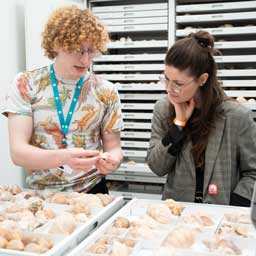
Example leaves from cold and warm floral assemblages, and the linear relationship between mean annual temperature and the proportion of entire margin (smooth) leaves.

Wolfe, J.A., 1979, Temperature parameters of humid to mesic forests of eastern Asia and relation to forests of other regions in the Northern Hemisphere and Australasia: USGS Professional Paper 1106, p. 1 - 37.
Our plan was to use a brand new method for estimating temperatures called “clumped isotopes,” a method partially pioneered in the Huntington lab at the University of Washington, to independently figure out which of these many plant-based methods would get us the right answer. This new method doesn’t rely on the plant fossils themselves to calculate a temperature, but instead uses the composition of different carbon dioxide molecules within the rocks that preserve those fossils.
Once I had located all the right fossils in the Burke’s paleobotany collections, I sampled the material around them with a tiny drill and then used the equipment in UW’s IsoLab to make new temperature estimates for the fossils.
The results were exciting! Not only could we resolve the issue of why these different plant-based methods didn’t give us the same answer, but we could also use all these robust new temperatures to say something about the paleoclimate of the western U.S.
Our comparison allowed us to choose which plant-based method works best in North America, which lets us estimate past temperatures in places where we have plant fossils but no carbonate-bearing (limestone) rocks. This opens up possibilities for more researchers to answer research questions using the plant fossils in the Burke collection!
But that wasn’t all that we learned. The new temperatures from all of these sites also told us something about past environments in the western U.S., particularly in the places where we had lots of samples like on the Colorado Plateau.
We noticed that the oldest samples (50 million years old) from the northern part of the plateau (Colorado, Utah) showed warmer temperatures than samples from the southern part of the plateau (Arizona, New Mexico), while the youngest samples (25 million years old) showed the opposite pattern.
As Seattleites know well, the higher you go in elevation the colder it gets, so what this new data told us was that the northern part of the plateau started out lower in elevation than the southern part, but over time grew to be higher. This makes sense if we think about modern elevations in the west, but it suggests something new about this area further back in the past—specifically it suggests that the Colorado River used to flow north instead of south.
This is an idea that geologists have argued about for many years, but elevation estimates from the plateau had previously been missing or confusing. Hopefully our new measurements will help put the debate to rest. Look for our results in an upcoming edition of the journal Earth and Planetary Science Letters!
---
Ethan Hyland is a University of Washington Future of Ice Postdoc, working with the departments of Earth & Space Sciences and Biology to study past climate and ecology in unique environments worldwide. His co-authors on this study are Kate Huntington, Associate Professor in the Department of Earth and Space Sciences, UW, and Nathan Sheldon, University of Michigan.





